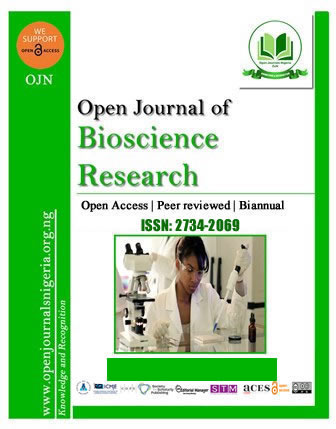ASSESSMENT OF EMERGENT AND FLOATING MACROPHYTES IN RELATION TO SOME PHYSICOCHEMICAL PARAMETERS OF WAYA POND, BAUCHI, NIGERIA
DOI:
https://doi.org/10.52417/ojbr.v2i2.287Keywords:
biodiversity, correlation, macrophytes, parameters, physicochemical, pond.Abstract
Emergent and floating macrophytes in relation to some physicochemical parameters were assessed in Waya pond, Bauchi. Water and macrophytes were sampled monthly between October 2019 to March 2020. Ten physicochemical parameters were measured and twelve macrophytes species recorded. The diversity index was 1.38, evenness (0.55) and abundance were 12 species. The site was polluted as all the values of dissolved oxygen (DO) were ˂ 5 mg/L, nitrogen ˃ 18 mg/L and pH ˂ 7 except for December. Pearson’s correlation coefficient revealed that DO correlated with Total Dissolved Solids (TDS) (r = 0.936, p˂0.01), Phosphate (r = 0.927, p˂0.01) and Nitrate (r = -0.953, p˂0.01). TDS correlated with Phosphate (r = 0.969, p˂0.01) and Nitrate (r = - 0.938, p˂0.01). The significant correlation between physicochemical parameters and macrophytes were: Nymphaea nouchali with DO (r = - 0.849, p˂0.05), TS (r = 0.88, p˂0.05). Panicum repens was negatively correlated with TDS, DO, TS, Phosphate but not Nitrates. Eichhornia crassipes, Nymphaea micrantha and Nymphaea lotus at p˂0.05 were negatively associated with TDS, DO, and Phosphate but positively with Nitrate. Nuphar lutea, Nelumbo nucifera and Echinochloa colona related positively with Turbidity. Nuphar lutea positively related with Nitrate but negative with DO, and TS. Typha latifolia with TS (r = - 0.871, p˂0.05). Potamogeton natans with phosphate (r = 0.927, p˂0.01). The state of water pollution in the study-area corresponded with low diversity, evenness and abundance of species. This puts biodiversity and sustainability at risk.
Published
How to Cite
Issue
Section
Copyright (c) 2021 Akwuma et al.

This work is licensed under a Creative Commons Attribution 4.0 International License.





















